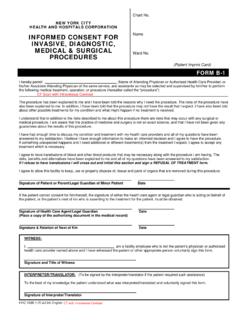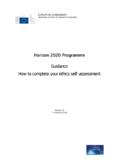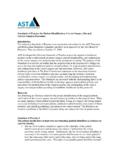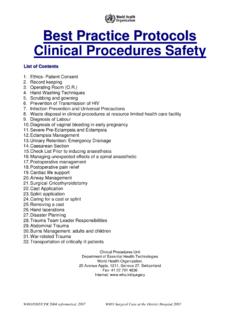Transcription of E ETTHHIICCSS--PPAATTIIEENNTT CCOONNSSEENNTT
1 WHO/EHT/CPR 2004 reformatted. 2007 WHO Surgical Care at the District Hospital 2003 EEETTTHHHIIICCCSSS---PPPAAATTTIIIEEENNNT TTCCCOOONNNSSSEEENNNTTT Before performing a procedure, it is important to receiveconsent from the patient:- ask permission to make an examination;- explain what you intend to do before doing it;- ask the patient if he/she has questions & answer them;- check that the patient has understood;- obtain permission to proceed; and- be mindful of the comfort and privacy of others. With invasive and surgical procedures, it is particularlyimportant to explain fully:- what you are proposing?- what are your reasons for wishing to undertake the procedure?
2 - what you hope to find or accomplish? Ensure that you:- use language that can be understood;- draw pictures and use an interpreter, if necessary;- allow the patient and family members to ask questions and thinkabout what you have said. It may be necessary to consult with a family member orcommunity elder who may not be present; allow for thisif the patient s condition permits. If a person is too ill to give consent (for example, ifunconscious) and their condition will not allow furtherdelay, you should proceed, without formal consent ,acting in the best interest of the patient. Record your reasoning and plan.(continued to next page)WHO/EHT/CPR 2004 reformatted. 2007 WHO Surgical Care at the District Hospital 2003 EEETTTHHHIIICCCSSS---PPPAAATTTIIIEEENNNT TTCCCOOONNNSSSEEENNNTTT(continued) informed consent means that:- patient and the patient s family understand what is to take place,- including the potential risks and complications of both proceedingand not proceeding, and have given permission for a course ofaction.
3 Some hospitals require patients to sign a documentindicating that the surgical procedure and potentialcomplications have been explained and that permissionto proceed has been granted. This paper is then includedin the patient s record. If this is not a formal requirement in your hospital,document the conversation in which consent was givenand include the names of people present at thediscussion. It should be a choice made free from coercion. Our duty as professionals to provide service and carecan come into conflict with our personal opinions. It isimportant to be aware of these feelings when they occurand to understand where they are coming from. If we are asked to care for someone who is alleged tohave committed a crime, it is not our responsibility toadminister justice.
4 Be attentive to legal, religious, cultural, linguistic andfamily norms and differences. However, itisour responsibility to provide care. This canbe difficult, but it is important to recognize that:- Our job is not to judge, but to provide care to all without regardto social status or any other By acting in this way, we will be seen to be fair and equitableby the community we 2004 reformatted. 2007 WHO Surgical Care at the District Hospital 2003 RECORD KEEPING Admission note/preoperative note Operating room recordsusually includes:- Patient identity- Procedure performed- Persons involved- Complications. Delivery book The operative note Postoperative notes can be organized in the SOAP format:Subjective: how the patient feelsObjective: findings on physical examination, vital signs and laboratory resultsAssessment: what the practitioner thinksPlan: management plan, this may also includedirectives which can be written in a specific location as orders.
5 Discharge note:record:- Admitting and definitive diagnoses;- Summary of patient s course in hospital;- Instructions about further management as an outpatient,including any medication and the length of administrationand planned 2004 reformatted. 2007 WHO Surgical Care at the District Hospital 2003 OOOPPPEEERRRAAATTTIIINNNGGGRRROOOOOOMMM( (( )))The operating theatre is a room specifically for use by theanaesthesia and surgical teams and must not be used forother requires:- Good lighting and ventilation;- Dedicated equipment for procedures;- Equipment to monitor patients, as required for theprocedure;- Drugs and other consumables for routine and that procedures are established for the correct useof all staff is trained to follow them: Keep all doors to the closed, except as needed for thepassage of equipment, personnel and the patient; Store some sutures and extra equipment in the todecrease the need for people to enter and leave the a case.
6 Keep to a minimum the number of people allowed to enterthe , especially after an operation has started; Keep uncluttered and easy to clean; Between cases, clean and disinfect the table and instrumentsurfaces; At the end of each day, clean the : start at the top andcontinue to the floor, including all furniture, overheadequipment and lights, use a liquid disinfectant at a dilutionrecommended by the manufacturer; Sterilize all surgical instruments and supplies after use andstore them protected and ready for the next use.(continued to next page)WHO/EHT/CPR 2004 reformatted. 2007 WHO Surgical Care at the District Hospital 2003 OOOPPPEEERRRAAATTTIIINNNGGGRRROOOOOOMMM( (( )))(continued)Sponge and Instrument Counts It is essential to keep track of the materials being used inthe in order to avoid inadvertent disposal or thepotentially disastrous loss of sponges and instrumentsin the wound.
7 It is standard practice to count supplies (instruments,needles and sponges)- Before beginning a case,- Before final closure,- On completing the procedure. Aim is to ensure that materials are not left behind or special attention to small items and sponges. Create and make copies of a standard list of equipmentfor use as a checklist to check equipment as it is set upfor the case and then as counts are completed during thecase. Include space for suture material and other consumablesadded during the case. When trays are created with the instruments for aspecific case, such as a Caesarean section, also make achecklist of the instruments included in that tray forfuture the ready for use in case of emergencyWHO/EHT/CPR 2004 reformatted. 2007 WHO Surgical Care at the District Hospital 2003 FAILURE OF NORMAL METHODS OFSTERILIZATIONF ailure of an autoclave or a power supply may suddenlyinterrupt normal sterilization an extra set of sterile equipment and drapes are notavailable, the following antiseptic technique will allowsome surgery to Immerse towels and drapes for 1 hour in a reliable antisepticsuch as aqueous chlorhexidine, wring them out and lay themmoist on the skin of the Treat gauze packs and swabs similarly, but rinse them indiluted (1:1000) chlorhexidine solution before using them in the wound.
8 From time to time during the operation, rinse gauze in use in this Immerse instruments, needles, and natural suture materialsin strong antiseptic for 1 hour and rinse them in weakantiseptic just before 2004 reformatted. 2007 WHO Surgical Care at the District Hospital 2003 CLEANING, DISINFECTION, STERILIZATIOND isinfection Disinfectant solutions are used to inactivate any infectiousagents that may be present in blood or other body fluids. They must always be available for cleaning workingsurfaces, equipment that cannot be autoclaved, non-disposable items, and for dealing with any spillagesinvolving pathological specimens or other known infectiousmaterial. Needles and instruments should routinely be soaked in achemical disinfectant for 30 minutes before cleaning.
9 Disinfection decreases the viral and bacterial burden of aninstrument, but doesnotclean debris from the instrumentor confer sterility. Purpose of disinfection is to reduce the risk to those whohave to handle the instruments during further cleaning. Reusable needles must always be used with great use, they should be placed in a special container ofdisinfectant before being cleaned and sterilized. Thick gloves should be worn when needles and sharpinstruments are being cleaned. There are many disinfectant solutions, with varyingdegrees of effectiveness. Most widely available is sodiumhypochlorite solution (commonly known as bleach orchloros), which is a particularly effective antiviraldisinfectant solution. To ensure effective disinfection, follow the manufacturer sinstructions or any other specific guidelines that have beengiven and dilute the concentrated solution to the correctworking strength.
10 It is important to use all disinfectant solutions within theirexpiry date as some solutions, such as hypochlorite, losetheir activity very quickly.(continued to next page)WHO/EHT/CPR 2004 reformatted. 2007 WHO Surgical Care at the District Hospital 2003 CLEANING, DISINFECTION, STERILIZATION(continued) All disinfectants have a contact time , which means thatthey must be left in contact with an infectious agent for acertain period of time to ensure that it is completelyinactivated. However, some disinfectants are themselvesinactivated by the presence of organic material, so higherconcentrations of disinfectant and longer contact timesmust be used in certain situations, such as a large spill ofinfected blood. Linen soiled with blood should be handled with gloves, andshould be collected and transported in leak-proof bags.














